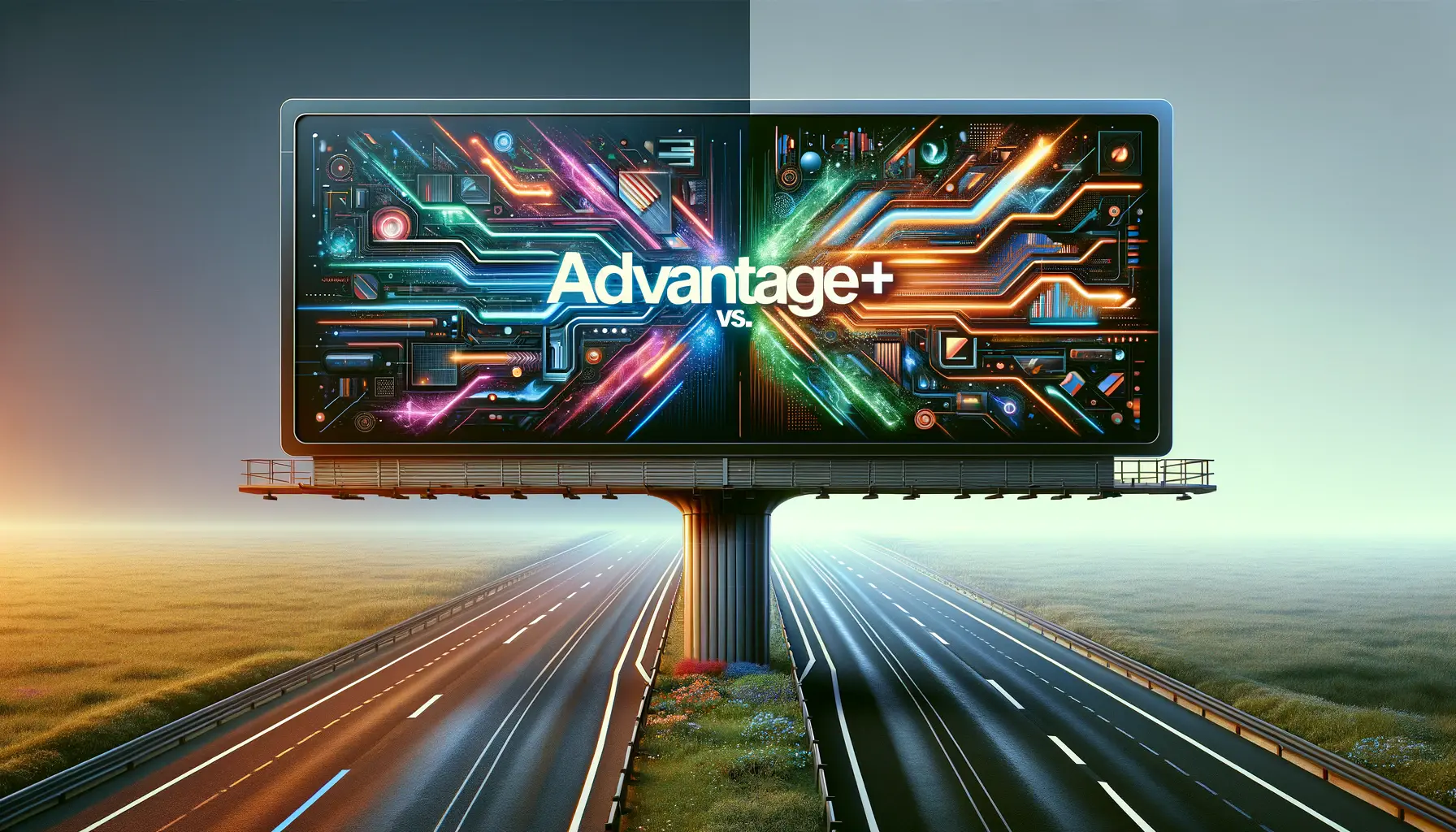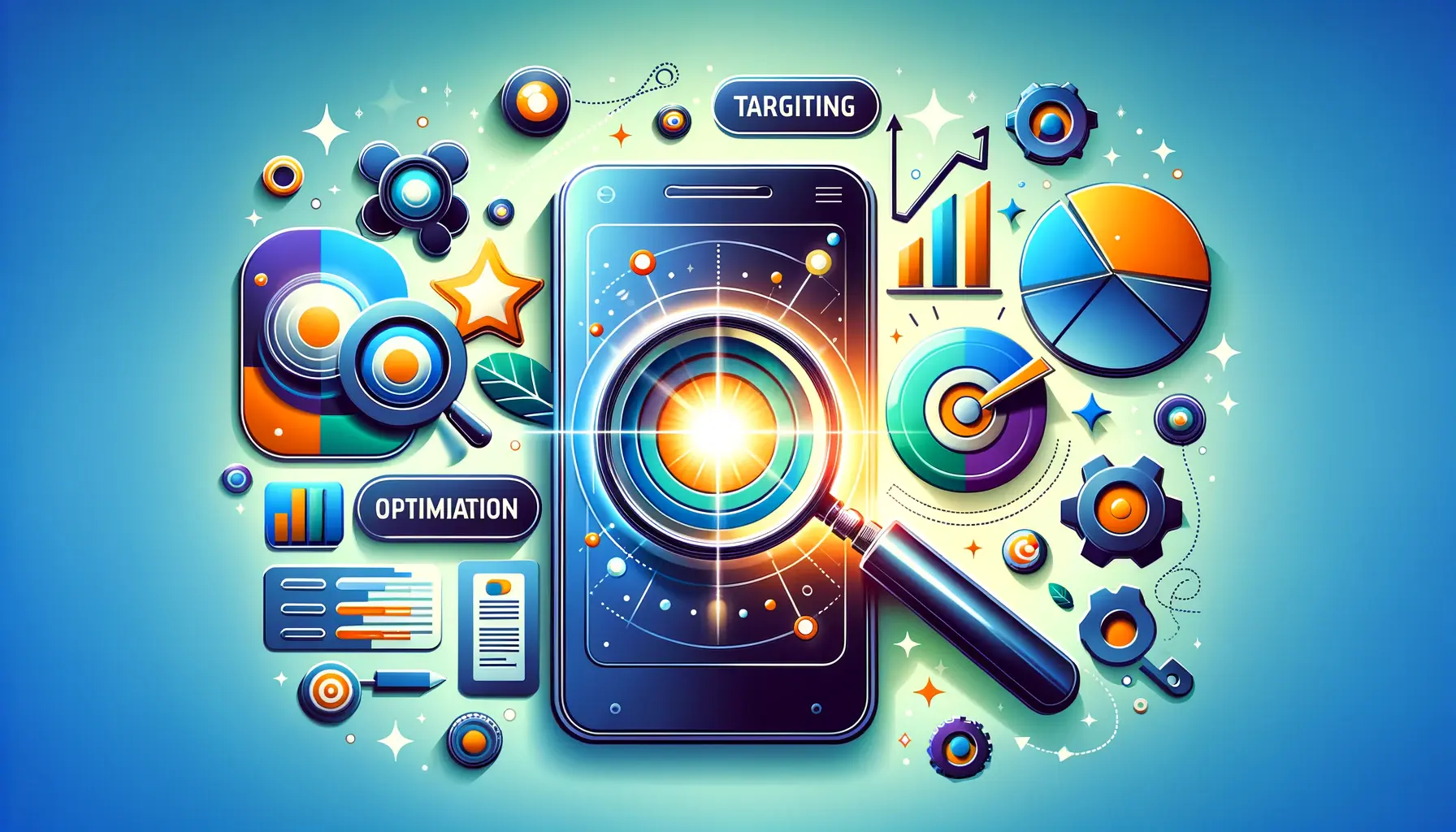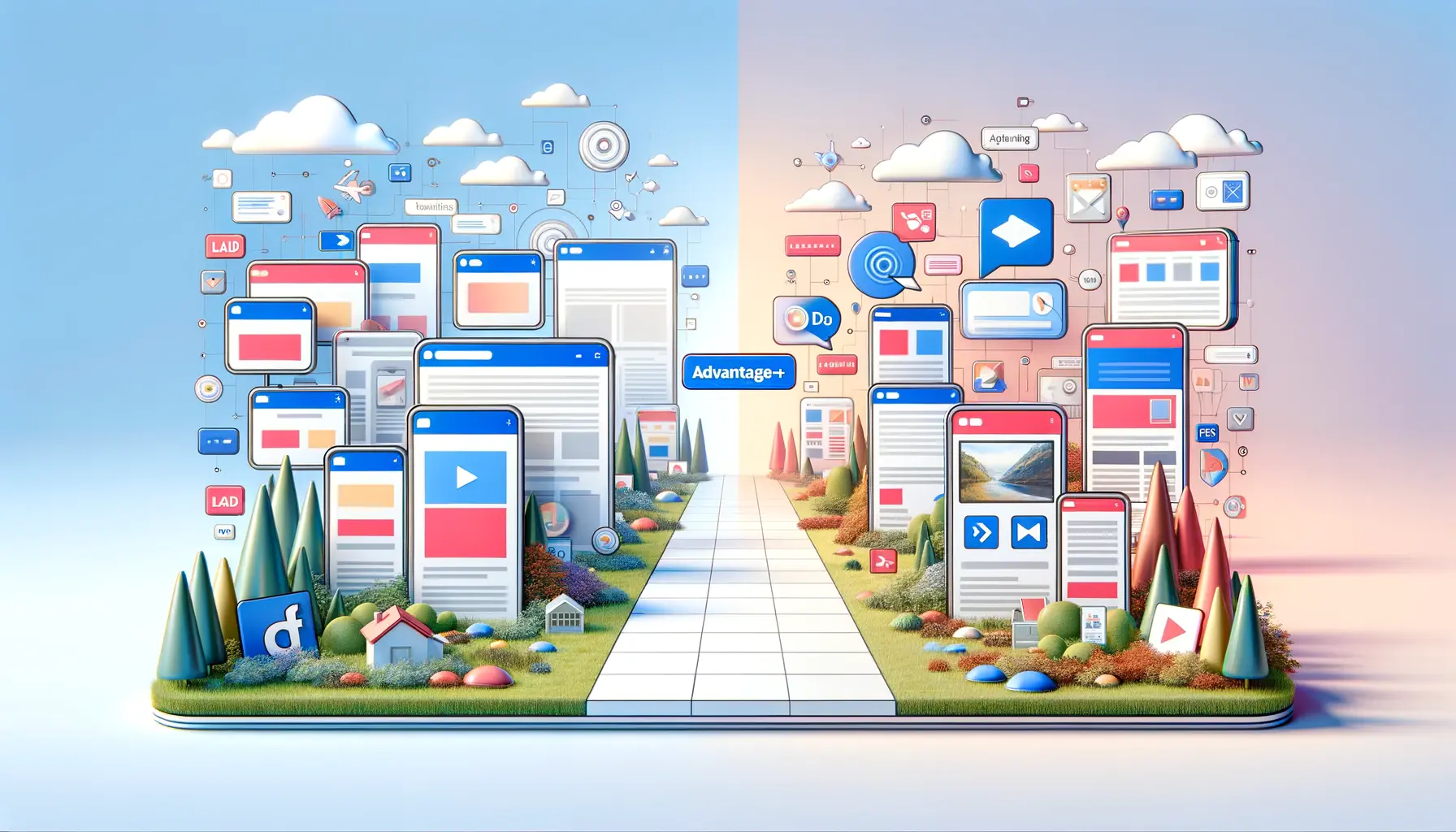In the ever-evolving landscape of digital marketing, the introduction of Facebook’s Advantage+ campaigns marks a significant shift in how businesses approach online advertising.
This innovative advertising model leverages artificial intelligence and machine learning to streamline the ad creation process, offering a more efficient way to reach target audiences.
As we delve into the world of Advantage+ versus traditional ads, it’s crucial to understand the nuances of each approach and how they can impact your marketing strategy.
Traditional ads have long been the backbone of digital marketing strategies, offering precise control over every aspect of the campaign.
From audience targeting to ad placement and budget allocation, marketers have relied on their expertise to optimize campaigns for maximum impact.
However, the digital advertising landscape is shifting towards more automated solutions, with Advantage+ campaigns at the forefront of this change.
By comparing these two models, we aim to uncover the advantages and potential drawbacks of each, providing valuable insights for businesses navigating the digital marketing domain.
- Understanding Advantage+ Campaigns
- Challenges and Considerations in Traditional Advertising
- Comparative Analysis: Performance and Efficiency
- Strategic Flexibility and Creative Control
- Adaptability to Market Changes
- Integration with Broader Marketing Strategies
- Future Outlook and Evolving Trends
- Embracing the Future of Digital Advertising
- Advantage+ vs. Traditional Ads FAQs
Understanding Advantage+ Campaigns
What Sets Advantage+ Apart
Advantage+ campaigns represent a new era in digital advertising, where efficiency and automation take center stage.
Utilizing Facebook’s vast data pool and sophisticated algorithms, Advantage+ aims to simplify the ad creation process, making it more accessible to businesses of all sizes.
This approach contrasts sharply with traditional ad campaigns, which require a more hands-on approach to targeting, creative design, and optimization.
The core of Advantage+ lies in its ability to automate several aspects of the advertising process.
By analyzing user behavior and preferences, the platform can dynamically adjust ad elements to serve the most relevant content to the right audience.
This not only reduces the workload for marketers but also enhances the potential for higher engagement rates and conversions.
Benefits of Automation and AI
One of the key advantages of Advantage+ campaigns is the integration of artificial intelligence and machine learning technologies.
These technologies enable the platform to continuously learn from campaign performance data, refining targeting and optimization strategies over time.
As a result, advertisers can expect improved efficiency and effectiveness from their campaigns, with less time spent on manual adjustments.
Furthermore, the automated nature of Advantage+ campaigns allows for a broader reach and more effective audience engagement.
By leveraging Facebook’s extensive user data, these campaigns can identify and target potential customers who are most likely to be interested in the advertised products or services.
This targeted approach, powered by AI, ensures that ads are more relevant to the audience, potentially leading to higher conversion rates.
Advantage+ campaigns harness the power of AI and machine learning to automate ad targeting and optimization, offering a streamlined approach to digital advertising.
Challenges and Considerations in Traditional Advertising
While Advantage+ campaigns offer a modern approach to digital advertising, traditional ads have been the cornerstone of online marketing strategies for years.
These campaigns provide marketers with granular control over every aspect, from audience segmentation to creative execution.
However, this level of control comes with its own set of challenges and considerations that businesses must navigate to achieve success.
One of the primary challenges of traditional advertising is the complexity of campaign management.
Marketers must make informed decisions on a wide range of variables, including:
- Audience targeting and segmentation
- Ad placement and scheduling
- Budget allocation and bid strategies
- Creative design and messaging
Each of these elements requires a deep understanding of the platform’s capabilities and the target audience’s behavior.
Additionally, traditional campaigns demand continuous monitoring and optimization to ensure they are performing as expected.
This can be a time-consuming process, requiring marketers to analyze data and adjust strategies accordingly.
Cost Implications and Resource Allocation
The hands-on approach of traditional advertising also has implications for cost and resource allocation.
Businesses must invest significant time and resources into campaign development, management, and optimization.
This includes the cost of tools and platforms for data analysis, as well as the human resources needed to execute and monitor campaigns.
For small businesses or those with limited marketing budgets, these costs can be prohibitive, limiting their ability to compete in the digital advertising space.
Keeping Up with Platform Changes
Another consideration for traditional advertising is the need to stay updated with frequent platform changes.
Social media platforms and search engines regularly update their algorithms and advertising features, requiring marketers to adapt their strategies to maintain campaign effectiveness.
This constant need for adaptation can be challenging, especially for businesses without dedicated marketing teams.
Despite the control and precision offered by traditional advertising, the complexity, cost, and need for continuous adaptation present significant challenges for marketers.
Comparative Analysis: Performance and Efficiency
When evaluating Advantage+ versus traditional ads, a key area of interest is the comparative analysis of performance and efficiency.
Both advertising models aim to achieve the highest possible return on investment (ROI), but they approach this goal differently, leveraging unique strengths and facing distinct challenges.
Advantage+ campaigns, with their AI-driven automation, excel in efficiency.
The system’s ability to dynamically adjust targeting and creative elements based on real-time data significantly reduces the manual effort required to manage campaigns.
This automation can lead to improved performance metrics, such as:
- Higher click-through rates (CTRs) due to more relevant ad placements
- Increased conversion rates as ads are optimized for audience engagement
- Lower cost per acquisition (CPA) through efficient budget allocation
Traditional ads, on the other hand, rely heavily on the marketer’s expertise and intuition to achieve similar outcomes.
The performance of these campaigns is closely tied to the marketer’s ability to:
- Accurately segment and target the intended audience
- Create compelling ad creatives that resonate with the target demographic
- Continuously monitor and tweak campaign settings for optimal performance
Measuring ROI and Success Metrics
Measuring the ROI of Advantage+ and traditional ads requires a comprehensive analysis of key performance indicators (KPIs).
For Advantage+ campaigns, success metrics might include automated insights provided by the platform, highlighting efficiency gains and engagement rates.
Traditional campaigns, however, often necessitate a more hands-on approach to data analysis, with success measured by comparing pre-defined goals against actual outcomes.
In both cases, the ultimate measure of success is the ability to achieve business objectives, whether that’s increasing brand awareness, driving sales, or engaging with a specific audience segment.
The choice between Advantage+ and traditional ads should therefore be guided by the specific needs and capabilities of the business, as well as the marketing team’s expertise and resources.
While Advantage+ campaigns offer efficiency and automated optimization, traditional ads provide control and customization, with performance dependent on the marketer’s skill and strategy.
Strategic Flexibility and Creative Control
The debate between Advantage+ and traditional ads often centers on the balance between strategic flexibility and creative control.
Each advertising model offers distinct advantages in how campaigns are conceptualized, executed, and managed, impacting the overall marketing strategy of a business.
Advantage+ campaigns prioritize efficiency and scalability, automating many of the decisions that marketers traditionally make manually.
This includes:
- Automated audience targeting based on algorithmic predictions
- Dynamic creative optimization to present the most effective ad variations
- Simplified campaign setup to reduce time-to-market for new initiatives
While this automation can significantly enhance campaign performance, it may also limit marketers’ ability to apply nuanced strategies or experiment with unconventional creative concepts.
The system’s reliance on historical data and predictive modeling means that highly innovative or targeted campaigns may not fully leverage the unique insights of the marketing team.
Customization and Hands-on Management
Traditional ads, by contrast, offer a high degree of strategic flexibility and creative control.
Marketers can tailor every aspect of the campaign to align with specific business goals, audience insights, and branding guidelines.
This level of customization enables businesses to:
- Experiment with niche targeting strategies to reach specific audience segments
- Develop unique creative concepts that differentiate the brand in a crowded marketplace
- Adjust campaign parameters in real-time based on performance data and market trends
However, this hands-on approach requires a significant investment of time and resources.
Marketers must continuously monitor campaign performance, analyze data, and make adjustments to optimize results.
For businesses with limited marketing bandwidth, the demands of traditional ad management may outweigh the benefits of increased control.
The choice between Advantage+ and traditional ads hinges on a business’s priorities for strategic flexibility, creative control, and the capacity to manage complex campaigns.
Adaptability to Market Changes
The digital advertising landscape is characterized by rapid and often unpredictable changes.
Platforms evolve, consumer behaviors shift, and new trends emerge with little warning.
The adaptability of Advantage+ and traditional advertising models to these changes is a critical factor in their long-term success and sustainability.
Advantage+ campaigns are designed with adaptability in mind.
The AI and machine learning algorithms that power these campaigns continuously analyze vast amounts of data, allowing them to respond to market changes in real-time.
This dynamic approach offers several advantages:
- Quick adjustment of targeting criteria to align with emerging trends
- Automatic optimization of ad creatives to maintain engagement
- Efficient reallocation of budget to the most effective channels and placements
This level of responsiveness can be particularly beneficial in fast-moving markets or during periods of significant consumer behavior shifts.
By leveraging the latest data, Advantage+ campaigns can maintain relevance and effectiveness without requiring constant manual oversight.
Traditional Ads: Precision and Personalization
Traditional advertising models, with their emphasis on manual control and customization, offer a different kind of adaptability.
Marketers can use their insights and expertise to anticipate market changes and adjust their strategies accordingly.
This proactive approach allows for:
- Detailed segmentation and targeting adjustments based on qualitative insights
- Personalized ad creatives that reflect the latest brand messaging and consumer preferences
- Strategic shifts in campaign focus to explore new markets or capitalize on trends
However, the effectiveness of this approach depends heavily on the marketing team’s ability to accurately predict changes and quickly implement adjustments.
In rapidly changing environments, the time required to manually update campaigns can result in missed opportunities or decreased relevance.
While Advantage+ campaigns excel in automatic adaptability to market changes, traditional ads offer the potential for precise, personalized adjustments based on marketer insights.
Integration with Broader Marketing Strategies
The effectiveness of any advertising model is not just in its standalone performance but also in how well it integrates with a business’s broader marketing strategies.
This integration is crucial for creating a cohesive brand experience across all customer touchpoints and maximizing the overall impact of marketing efforts.
Advantage+ campaigns, with their automated and data-driven approach, can seamlessly integrate with digital marketing strategies that prioritize efficiency and scalability.
The use of AI to optimize ad delivery and targeting aligns well with strategies that leverage big data and analytics for decision-making.
Key integration points include:
- Syncing with CRM platforms to leverage customer data for targeting
- Utilizing website analytics to inform ad content and placement
- Coordinating with email marketing campaigns for consistent messaging
This level of integration supports a unified marketing approach, ensuring that ads are not only effective in isolation but also contribute to the broader goals of increasing brand awareness, customer engagement, and conversion rates.
Traditional Ads: Customization and Brand Consistency
Traditional advertising models offer a different set of integration benefits, particularly around customization and brand consistency.
By allowing for detailed control over every aspect of the campaign, marketers can ensure that ads fully reflect the brand’s voice, values, and visual identity.
This is especially important for businesses with strong brand narratives or those operating in highly competitive markets.
Integration with broader marketing strategies might involve:
- Aligning ad campaigns with offline marketing efforts for a consistent brand experience
- Customizing ad messages to complement content marketing initiatives
- Coordinating ad timing and themes with product launches and promotional events
Such integration ensures that traditional ads not only reach the intended audience but also reinforce the overall marketing message, contributing to a cohesive and compelling brand story.
Whether opting for the automated efficiency of Advantage+ or the detailed control of traditional ads, the key to success lies in how well the chosen model integrates with and supports the business’s overall marketing strategy.
Future Outlook and Evolving Trends
The digital advertising space is constantly evolving, with new technologies, platforms, and consumer behaviors shaping the future of how businesses connect with their audiences.
Understanding the future outlook and evolving trends is essential for marketers to stay ahead and make informed decisions about using Advantage+ versus traditional advertising models.
Advantage+ campaigns are at the forefront of leveraging AI and automation in advertising, a trend that is only expected to grow.
As machine learning algorithms become more sophisticated, we can anticipate even more personalized and efficient ad experiences.
Future developments may include:
- Enhanced predictive targeting capabilities
- Greater integration with augmented reality (AR) and virtual reality (VR) for immersive ad experiences
- Automated creative generation based on real-time data insights
These advancements promise to make Advantage+ campaigns even more effective, offering unprecedented levels of engagement and personalization.
Traditional advertising, while potentially seen as less innovative, still holds significant value in the evolving digital landscape.
Its strength lies in the ability to craft highly customized and nuanced campaigns that resonate deeply with specific audience segments.
Future trends that could impact traditional advertising include:
- The increasing importance of privacy and data protection, requiring more transparent and consent-based targeting strategies
- The rise of niche platforms and channels, offering new opportunities for targeted outreach
- Advancements in creative tools and technologies, enabling more dynamic and interactive ad formats
As these trends unfold, the choice between Advantage+ and traditional ads will increasingly depend on the specific goals, resources, and capabilities of each business.
Marketers must stay informed and adaptable, ready to leverage the best of both worlds to achieve their advertising objectives.
Assuming that one advertising model is inherently superior to the other overlooks the dynamic and multifaceted nature of digital marketing. The future of advertising will likely embrace the strengths of both Advantage+ and traditional models, guided by evolving technologies and consumer expectations.
Embracing the Future of Digital Advertising
The journey through the realms of Advantage+ and traditional ads illuminates the diverse landscape of digital advertising.
As businesses navigate this terrain, the choice between automated efficiency and manual precision becomes a strategic decision, reflecting broader marketing objectives and the evolving digital ecosystem.
The future of digital advertising, enriched by technological advancements and shifting consumer preferences, demands a nuanced understanding of these models’ strengths and limitations.
Striking a Balance
In the quest for optimal advertising performance, the balance between Advantage+ campaigns and traditional ads is not a binary choice but a spectrum of opportunities.
Marketers are encouraged to:
- Experiment with both models to understand their unique value propositions.
- Leverage the data-driven efficiency of Advantage+ for broad-reaching campaigns.
- Utilize the customization capabilities of traditional ads for targeted, brand-centric initiatives.
This balanced approach allows businesses to harness the best of both worlds, adapting their strategies to meet changing market demands and consumer behaviors.
Preparing for the Future
As we look towards the future, the digital advertising landscape is set to become more dynamic, with emerging technologies offering new ways to engage audiences.
Businesses that stay informed about these trends and remain flexible in their advertising strategies will be best positioned to thrive.
Key considerations for future-proofing your advertising efforts include:
- Investing in skills and technologies that enhance adaptability to new advertising models.
- Staying abreast of regulatory changes and consumer sentiment around privacy and data use.
- Exploring new platforms and media formats that align with your audience’s preferences.
Ultimately, the evolution of digital advertising is a testament to the industry’s innovation and resilience.
By embracing both Advantage+ and traditional ads, marketers can create compelling, effective campaigns that resonate with their audiences and drive business success.
Enjoyed the article? Let its author handle your social media ads. Visit our service page to get started!
Advantage+ vs. Traditional Ads FAQs
Explore common queries surrounding the innovative Advantage+ campaigns and traditional advertising methods to enhance your marketing strategy.
Advantage+ campaigns utilize AI and automation to streamline ad creation, targeting, and optimization, reducing manual effort.
Traditional ads offer more manual control over targeting, creative design, and campaign management compared to the automated Advantage+.
Yes, by leveraging AI for optimization, Advantage+ campaigns can potentially offer higher ROI through efficient targeting and reduced costs.
Traditional ads may incur higher costs due to the need for more hands-on management and optimization efforts.
Yes, Advantage+ campaigns automate many decisions, offering less creative control than traditional advertising methods.
Advantage+ campaigns automatically adjust to market changes using real-time data, maintaining campaign effectiveness.
Yes, traditional ads are ideal for niche targeting due to their granular control over audience segmentation and ad customization.
Small businesses may prefer Advantage+ for its efficiency and lower management requirements, though traditional ads offer precise targeting.












